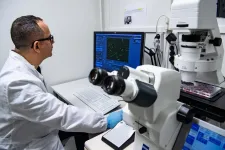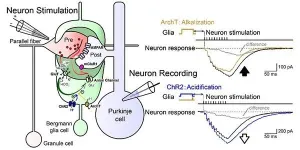(Press-News.org) Many materials in the modern world--from the plastics that dominate it to the electronic chips that drive it--are constructed of polymers. Given their ubiquity and the evolving requirements of our world, finding better and more efficient methods of making them is an ongoing research concern. In addition, current environmental issues necessitate the use of methods and input materials that are environment friendly.
Recent research by scientists from Nagoya Institute of Technology, Japan, has been in this vein, adding a new twist to a polymerization technique that has been around and successful since the 1980s: living cationic polymerization, where the polymer chain growth does not have the ability to terminate until the monomer is consumed. The scientists have, for the first time, demonstrated metal free organocatalysis for this reaction at room temperature for vinyl and styrene polymers, two of the most common polymers used in plastics. Their method is not only more efficient than current metal-based methods, but also environment friendly. Their findings are published in the Royal Society of Chemistry's Polymer Chemistry.
In their study, they first tested the applicability of non-ionic and multidentate (or several electron-pair accepting) halogen bonding organocatalysts, specifically two iodine-carrying polyfluoro-substituted oligoarenes, to the living cationic polymerization of isobutyl vinyl ether. Mentioning one of their reasons for choosing this, Dr. Koji Takagi, lead scientist in the study, explains in an aside: "The non-ionic characteristic is advantageous because the catalyst is soluble in less polar solvents like toluene which is more suitable for such polymerization of vinyl monomers."
They found that with the tridentate variant, the reaction smoothly progressed even at room temperature, producing good yield--though less than the theoretical limit--in a reasonable amount of time, without the catalyst decomposing or appearing as an impurity in the product. As Dr. Takagi explains, this could be a good advantage over existing metallic catalysts used in industry: "While metal-based catalysts have significantly contributed to the materials sciences over the past century, the contamination of remaining metallic impurities often brings about a decrease in the produced materials' lifetime and performance. We believe that the present finding will lead to the production of highly pure and reliable polymeric materials."
In saying this, he is, of course, referring to the other major finding in the study as well. The second part of their study involved evaluating the applicability of ionic iodoimidazolium catalysts with various counter anions (the negative ions accompanying the positively charged group) to the polymerization of p-methoxystyrene (pMOS) and unsubstituted styrene, the latter of which is more difficult to polymerize than the former.
pMOS easily polymerized at room temperature within two hours and with no catalyst decomposition of a bidentate 2-iodoimidazolium salt that had a triflate counter anion. Unsubstituted styrene gave maximum polymer yield via a reaction at -10°C for 24 hours with an anion-stabilizing and bulky counter ion-containing catalyst.
Speaking of the products yielded, Dr. Takagi says: "Although the obtained polymers are not intended for any specific purpose, our methodology is expected to be applied to the synthesis of conductive polymers and degradable polymers, which should not include metallic impurities if they're to be constructed for practical use."
Indeed, the findings are invaluable for moving forward with the more efficient production of polymeric materials for a variety of applications. However, the successful use of organocatalysts at room temperature also offers several other advantages. For one, organocatalysts lack sensitivity to moisture and oxygen, taking care of the sometimes serious problem that the relatively hygroscopic nature of ionic catalysts poses to such controlled polymerization reactions. Further, they are readily available and therefore, low cost. They are also not toxic to the environment. And when reactions are conducted at room temperature, the energy requirements are low.
This study is, thus, paving the way for low cost electronics in the future that are made of environment friendly materials in sustainable ways.
INFORMATION:
*This study was made available online in October 2020 ahead of final publication in issue on November 14, 2020
About Nagoya Institute of Technology, Japan
Nagoya Institute of Technology (NITech) is a respected engineering institute located in Nagoya, Japan. Established in 1949, the university aims to create a better society by providing global education and conducting cutting-edge research in various fields of science and technology. To this end, NITech provides a nurturing environment for students, teachers, and academicians to help them convert scientific skills into practical applications. Having recently established new departments and the "Creative Engineering Program," a 6-year integrated undergraduate and graduate course, NITech strives to continually grow as a university. With a mission to "conduct education and research with pride and sincerity, in order to contribute to society," NITech actively undertakes a wide range of research from basic to applied science.
Website: https://www.nitech.ac.jp/eng/index.html
About Associate Professor Koji Takagi from Nagoya Institute of Technology, Japan
Dr. Koji Takagi is currently an Associate Professor with the Department of Life Science and Applied Chemistry at Nagoya Institute of Technology, Japan. Between completing his doctoral degree in Engineering from the Tokyo Institute of Technology in 1998 and joining this post, he has been part of several academic societies including the American Chemical Society. His research interests lie in polymer chemistry, synthetic chemistry, functional solid-state chemistry, device-related chemistry, and organic and hybrid materials. To date, he has contributed to 93 papers and 5 books, and taken part in several prominent projects and presentations.
New York, February 24, 2021 - Graduate Center, CUNY/Brooklyn College professor was part of a discovery of the first fossil evidence of any primate, illustrating the earliest steps of primates 66 million years ago following the mass extinction that wiped out all dinosaurs and led to the rise of mammals.
Stephen Chester, an assistant professor of anthropology and paleontologist at the Graduate Center, CUNY and Brooklyn College, was part of a team of 10 researchers from across the United States who analyzed several fossils of Purgatorius, the oldest genus in a group of the earliest-known primates called plesiadapiforms. ...
According to a new study published in The American Journal of Human Genetics, more than one third of genetic variants that increase the risk of coronary artery disease regulate the expression of genes in the liver. These variants have an impact on the expression of genes regulating cholesterol metabolism, among other things. The findings provide valuable new insight into the genetics of coronary artery disease. The study was conducted in collaboration between the University of Eastern Finland, Kuopio University Hospital, the University of California Los Angeles, and the University of Arizona.
Coronary artery disease (CAD) and its most important complication ...
Australian researchers have called for additional services for survivors of intimate partner violence - warning those who have these experiences are more vulnerable to elder abuse.
Women who survive domestic violence continue to experience negative effects well into their older years but they are also more vulnerable to elder abuse, says Flinders University researcher Dr Monica Cations, lead author of the study published in the American Journal of Geriatric Psychiatry.
"This is the first time this relationship has been demonstrated and tells us that older survivors need close monitoring and prevention efforts to keep them safe from further abuse."
The study looked at the psychological and physical impacts and risk for elder abuse associated ...
Before the corona pandemic, tens of millions international travellers annually headed to the tropics, getting exposed to local intestinal bacteria. A total of 20-70% of those returning from the tropics carry - for the most unknowingly - ESBL-producing bacteria resistant to multiple antibiotics. The likelihood of acquiring such superbacteria depends on destination and health behaviour abroad. The risk is greatest in South and Southeast Asia, and a substantial increase is associated with contracting travellers' diarrhoea and taking antibiotics while abroad.
An investigation led by professor ...
Tohoku University scientists have shown that neuronal and glial circuits form a loosely coupled super-network within the brain. Activation of the metabotropic glutamate receptors in neurons was shown to be largely influenced by the state of the glial cells. Therefore, artificial control of the glial state could potentially be used to enhance the memory function of the brain.
The findings were detailed in the Journal of Physiology.
Although the glial cells occupy more than half of the brain, they were thought to act as glue--merely filling the gap between neurons. However, recent findings show that the concentration of intracellular ions in glia, ...
A new theoretical study has proposed a novel mechanism for the creation of supermassive black holes from dark matter. The international team find that rather than the conventional formation scenarios involving 'normal' matter, supermassive black holes could instead form directly from dark matter in high density regions in the centres of galaxies. The result has key implications for cosmology in the early Universe, and is published in Monthly Notices of the Royal Astronomical Society.
Exactly how supermassive black holes initially formed is one of the biggest problems in the study of galaxy evolution ...
A German-Polish research team has succeeded in creating a micrometer-sized space-time crystal consisting of magnons at room temperature. With the help of the scanning transmission X-ray microscope Maxymus at Bessy II at Helmholtz Zentrum Berlin, they were able to film the recurring periodic magnetization structure in a crystal. Published in the Physical Review Letters, the research project was a collaboration between scientists from the Max Planck Institute for Intelligent Systems in Stuttgart, Germany, the Adam Mickiewicz University and the Polish Academy of Sciences in Pozna? in Poland.
Order in space and a periodicity in time
A crystal is a solid whose atoms or molecules are regularly arranged in a particular structure. If one looks at the arrangement with a microscope, one discovers ...
Today's quantum computers contain up to several dozen memory and processing units, the so-called qubits. Severin Daiss, Stefan Langenfeld, and colleagues from the Max Planck Institute of Quantum Optics in Garching have successfully interconnected two such qubits located in different labs to a distributed quantum computer by linking the qubits with a 60-meter-long optical fiber. Over such a distance they realized a quantum-logic gate - the basic building block of a quantum computer. It makes the system the worldwide first prototype of a distributed quantum computer.
The limitations of previous qubit architectures
Quantum ...
A new study, published today in Nature Digital Medicine, found that 'natural language processing' (NLP) of information routinely recorded by doctors - as part of patients' electronic health records - reveal vital trends that could help clinical teams forecast and plan for surges in patients.
The researchers from King's College London, King's College Hospital NHS Foundation Trust (KCH), and Guy's and St Thomas' Hospital NHS Foundation Trust (GSTT), used NLP algorithms to translate the electronic notes made by doctors into a standardised, structured set of medical terms that could be analysed by a computer.
Tracking trends in patients
In the ...
Social distancing - from mobility restrictions to complete lockdowns -- can take many weeks, possibly even months, a potentially devastating outcome for social and economic stability. One of the challenges is that the sick cannot be selectively isolated, since many of the spreaders remain pre-symptomatic for a period ranging from several days to as much as two weeks - invisible spreaders who continue to be socially active. Hence, it seems that without a population-wide lockdown isolating the carriers cannot be achieved effectively.
To bypass this challenge, researchers from Israel's Bar-Ilan University, led by Prof. Baruch Barzel, devised a strategy based on alternating lockdowns: first splitting the population into two groups, then ...




